FREE eBooks & 7-Dimensional eCommunications
from Ken Kozy - Writer & Speaker2017 - Read the eBook PART 2 on-Line
This page contains the text and graphics
for Part 2
Following the text are MULTI - DIMENSIONAL LINKS to see and hear interesting Music Videos - Traditional, Modern, or New versions. (All these LINKS are to YouTube®©.)
After that are MULTI - DIMENSIONAL LINKS to experience 3-D Tours, Photos, Videos, Maps, Bible References, Food Recipes and additional interesting information.
A BABY
CHANGES OUR WORLD
Part 2
Tour of Bethlehem
Following the text are MULTI - DIMENSIONAL LINKS to see and hear interesting Music Videos - Traditional, Modern, or New versions. (All these LINKS are to YouTube®©.)
After that are MULTI - DIMENSIONAL LINKS to experience 3-D Tours, Photos, Videos, Maps, Bible References, Food Recipes and additional interesting information.
A BABY
CHANGES OUR WORLD
Part 2
Tour of Bethlehem
Mary looks directly at me. “You are tall and intelligent for your young age. You speak very clearly, Matthias.”
“Thank you. When my father and I were in the Shepherds’ Field, he taught me how to tend our sheep and to memorize prayers and scripture. Our mother teaches us something new every night at home. I love to learn. Also, our Rabbi teaches us in the synagogue school. But sometimes my friends think I know and talk too much, so they don’t want to play with me.”
Joseph overhears us as he repairs the wooden mangers and comments, “It’s more than learning. You have many gifts from God – a good memory, a quick mind, and sensitivity. Early in life you had to learn to work as hard as a man. You are becoming the man of your family. I have not met anyone so young who is so bright. Don’t worry, your friends will understand you better as everyone grows up.”
Mary interposes, “Matthias, I have never been to Bethlehem before, so I’m hopeful you can tell me about this area.”
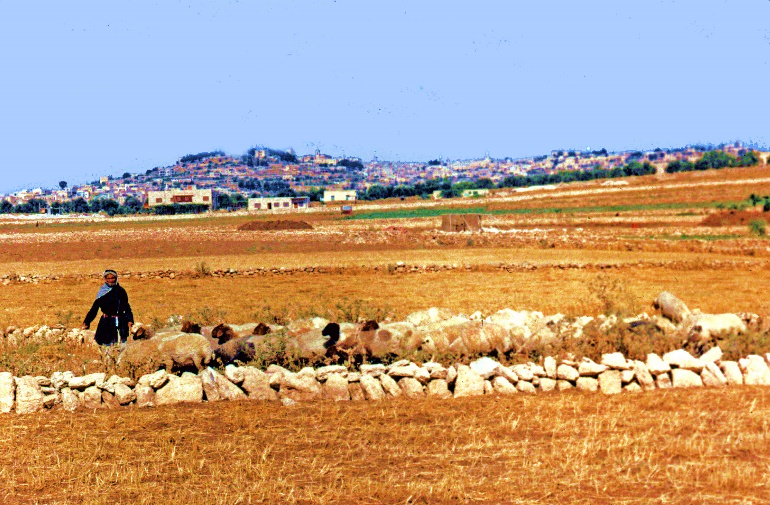
Fig. 1. Bethlehem in the hills of Judea rises in the background of the flock of sheep and shepherd.
Excitedly, I quickly respond to her request, “I’m always happy to talk about my little town. Bethlehem is located on top of a couple of hills in Judea. Its name means ‘House of Bread’ although some say it means “House of Meat’ because of our plentiful sheep sold to the marketplace.”
Mary asks, “Bethlehem is so small, so why is there this Inn?”
“My father told me we are next to a trade route that connects with other roads. Traders travel from Egypt in the south, through Judea, and continue up to the Roman Province of Syria in the north. Then they return the same route. Many caravans of traders load their pack animals with goods or even metal ore. That’s why they stop here on their way to or from Jerusalem. So, Bethlehem has this Inn where they can stay overnight to rest and to water and feed their animals for travel.”
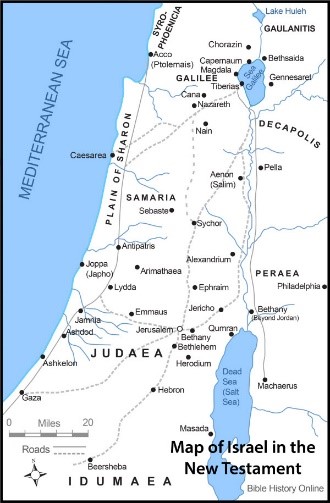
Fig. 2. Map of roads and trade routes (---) around Bethlehem, Jerusalem and Nazareth in first century.
Mary gets up and walks over to the entrance of the cave. “The landscape is beautiful. How large is Bethlehem?”
I enjoy answering her questions, “Bethlehem has a small synagogue, and our teacher, Rabbi Levi, says that our town and its surrounding community only have a population of about 240 people including children; about 10 boys are born here each year—he knows because he circumcises them according to God’s Law transcribed by Moses. Our Rabbi says, ‘Bethlehem is really just a rural town about 6 miles south of Jerusalem.’”
I point eastward. “In that beautiful valley which you see in the distance, farmers tell me they grow vegetables, olive trees, barley and hay for sale to us and to the large street markets in Jerusalem.
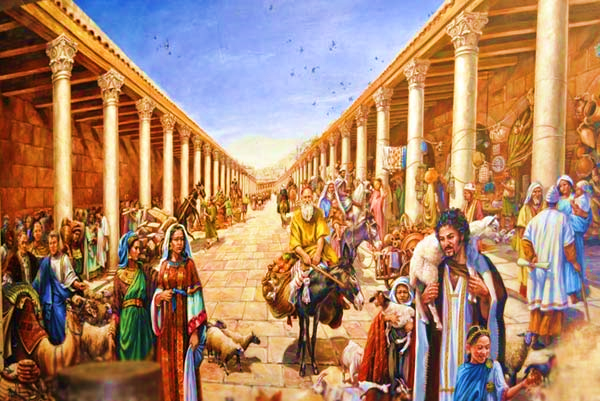
Fig 3. Jerusalem Marketplace.
“The nearby Shepherds’ Field directly borders the east side of Bethlehem. Its springtime flowers and fall grasses are a beautiful sight and scent. My friends and I run through the flowers and chase each other just for the fun of it.
“Rabbi Levi says Bethlehem is best known for its unblemished sheep. God commanded a daily sacrifice of two unblemished lambs. Also, for forgiveness of personal sins it is required that a man offers an unblemished lamb as sacrifice. Therefore, the Rabbi tells us, many lambs are needed daily and especially during Passover when many faithful come to visit the Temple in Jerusalem.
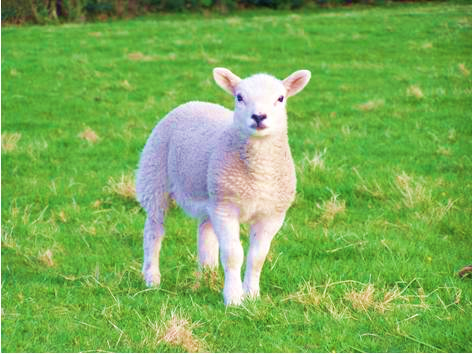
Fig. 4. Unblemished Lamb.
“Last year my father took me to see the Shepherds’ Field on the north-east side of town, along the road to Jerusalem. That area contains the flocks that will become the unblemished sacrifices in the Temple. Special, scripture-trained shepherds look at each of the new-born lambs. They’re carefully inspected, separated and protected against blemishes so they can be offered for the daily Temple services.
“Standing tall in that Shepherds’ Field is the ‘Tower of the Flock.’ It’s a stone lookout tower and a birthing stable area. There, new-born lambs are wrapped in swaddling cloth to protect them from any bruises until they are strong enough to endure.
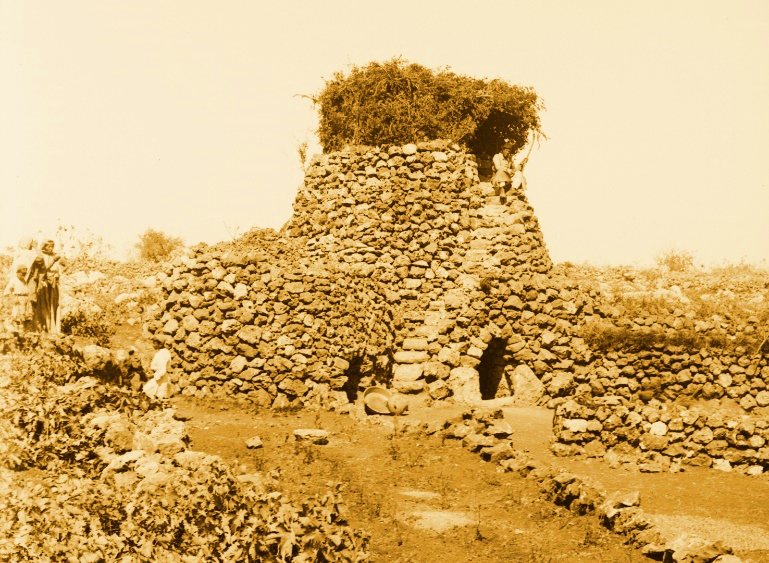
Fig. 5. A “Tower of the Flock”.
"My father told me that Micah, our prophet, predicted that in this area around the Tower and Bethlehem the Messiah would be born." Mary and Joseph both smile broadly, but say nothing. I wonder what they are thinking.
Next, I point to the south-east. “The Shepherds’ Field in this other direction contains flocks of sheep grown mainly for their wool to be spun into cloth for our clothes. They are also sold for meat and other products such as parchment.
“My father grazed his flock in that area. I was always happy when he took me along to stay with him and the flock overnight. As a result, I know its landscape very well. It’s hilly with many stones and steep craggy drop offs–suited only for grazing of animals. No crops are raised in these areas. The sheep are not allowed to wander into the farmers’ crop areas in the distant valley.”
Mary seems in awe, “All this countryside is such a beautiful sight from here!”
Joseph looks up from his carpentry work and turns to Mary. He softly says, “This is the area where our ancestor, King David, was born and raised about 1,000 years ago.”
I turn towards Mary, also. “Did you know that King David tended his family’s flock of sheep here in Bethlehem? My father told me that David fought a lion and a bear to protect his sheep.” Mary responds, “That sound very exciting. Tell me more.” “Well, David was the youngest boy of Jesse’s family and was given the responsibility of grazing and protecting their sheep in this field. Daily, he practiced with his simple sling shot using small rocks. Eventually, he became very accurate in his aim.
“As you may know, the prophet Samuel secretly anointed David as God’s choice to eventually become the next King of Israel. God told him whom He chose and that he would be ‘a man after my own heart’.
“David grew-up in these same hills of Bethlehem, close to where his famous grandmother, Ruth, lived. She tutored him in his early years.
“Good thing David was a marksman with his slingshot, because there were wild animals in the area who preyed on the defenseless sheep for food. David would chase those predators, including wild dogs and lions, whenever they attacked his sheep. Using his sling shot and some round rocks, those projectiles hit the predators with bone-breaking force. They would whimper away, leaving the sheep alone. Then, David would carry the sheep back and bind up its wounds to recover from the attack.
“Once a bear turned on David after being hit by those rocks, but God was with David. He killed the bear with another close-up shot of his sling-a rock right between its eyes! What a shot! They say it almost came out the back of the bear’s head. David became a local hero.
“Later, when the 9 foot-tall giant Philistine soldier, Goliath, cursed Israel and our God, our army was terrified and no one would face him alone in battle.
“Meanwhile, David was sent by his father to take food to his brothers who were in Israel’s army right at the front lines. When he heard the giant’s curses, he became angry and volunteered to fight Goliath. He told King Saul that the same God who delivered him from the claws of the bear would deliver him from the hands of this Philistine.
“King Saul laughed that this young boy without any military training would attempt to do this, but gave his permission. David rejected any sword or armor and just picked up a few rocks and with his sling shot and wooden staff he headed right for the Philistine.
Sure enough, David told Goliath that by the power of God, the Lord of Hosts, he would take down the giant. He did.
“With his slingshot, he send a rock deep into the giant’s forehead. Goliath fell forward. Then, David took the giant’s sword and cut off his head. The Philistine army was shocked and turned fearful. Our soldiers gave out their battle cry and attacked, beating the enemy all the way back to their Philistine forts. David became our national hero.
“He is my hero as a shepherd boy, too. He later became a great King of Israel. His descendants also became Kings of our land as promised by God.”
Mary seems impressed.
Joseph is listening to me while working and smiles. “You have given Mary an excellent description of Bethlehem and its hero. Thank you. The Bethlehem area seems much the same as I remember when I lived here as a young boy.”
Mary turns to my sister, “Sarah, Matthias says your family lives next to this cave?”
Sarah’s face lights up with excitement as she answers, “Yes. The cave next door is our home. It’s about the same size as yours. There seems to be just enough room for the four of us. We store our few possessions on top of the selves that were cut out of the rock years before.
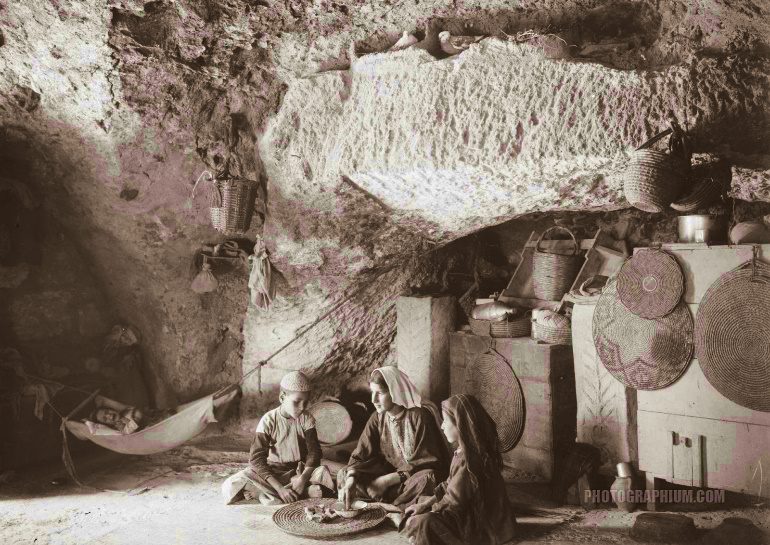
Fig. 6. Joseph leads Mary riding on a donkey
(Image Source: United States Postal Service®
© United States Postal Service. All rights reserved).
“Normally Mom brings us cooked food that are leftovers from the Inn. When we have something special to cook for ourselves we do it in the open area in front of the cave. There’s a large space in front of these caves, but the ground is made up of bumpy rocks and stones.
“We use the innkeeper’s fresh straw to cover the rock floor of our home.
“Mom taught me how to weave and we made some blankets from the wool of our sheep–which we sheared before our flock was stolen. Our wool has a pretty, light purple tint because Mom adds a little dye to the first wash. At night we pull those cozy blankets under and over us to sleep comfortably. Mom also made some clothes for us from her weavings and sewing.”
I add my feelings, “But the main thing is we are together–‘very together’ in this small space we call home. And we love each other.”
Joseph laughs. “That you do. Your love and respect for each other and your love of our God is very obvious. Matthias, tell me, have you visited the monument tomb built to honor Rachel?”
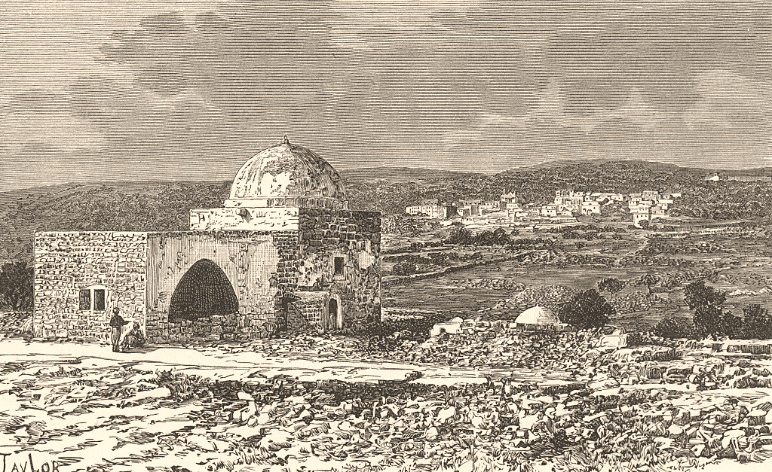
Fig. 7. Rachel’s Tomb, Bethlehem area. Drawing perhaps done around 1900. Originally, Jacob placed only a stone pillar as a marker around 1500 B.C. Over the centuries, buildings were constructed to protect and honor this site.
“Yes,” I report, “Several times–when my Dad took us north on the road to Jerusalem for the festivals at the Temple.”
Joseph goes on, “Rachel was the wife of Jacob, our patriarchal ancestor, whom God named ‘Israel.’ As children we used to run up there and after a rest, we would race back here to see who was the fastest!”
I feel good Joseph is sharing his story about Rachel’s memorial and I ask him, “Do you know Mom was named Rachel by her parents when she was born in northern Galilee?”
“We know your mother’s name from the innkeeper who introduced her to us when she offered to help us. Rachel is a beautiful name.”
Mary interposes. “You children speak very well. You will grow up to be wise adults.”
She sighs, “But for now, I’m really thirsty. May I have a drink of water? Suddenly, I’m very tired.”
Sarah jumps up to pour some water for Mary and then passes the water jar to us. This activity awakens Isaac from his nap. He just sits up and laughs.
Joseph helps Mary back into the cave to lie down and rest.
I jump up too, “That reminds me, I promised to take your donkey to the stream to drink some water. I’ll do that now!”
---------------------------- End of Part 2
(Continue below to experience: Multi-Dimension LINKS)
MULTI - DIMENSIONAL LINKS
Click Gold highlighted internet LINKS to see and hear interesting Music Videos
Traditional, Modern, or New versions.
All these LINKS are to YouTube®©.
Modern presentation of a traditional Christmas carol with lyrics: “Mary, did you know?” Sung by Pentatonix.
Popular song: “Like A Shepherd” written and sung by Bob Dufford - Saint Louis Jesuits. With lyrics.
Classic: “The Lord Is My Shepherd” Psalm 23. Mormon Tabernacle Choir. Choral Music, Flute, Harp, and Oboe.
Classical: "All we like sheep have gone astray" From George Frideric Handel's "The Messiah" by The English Concert with Score shown.
Classical: “Sheep May Safely Graze” FCantata No. 208 by J. S. Bach. Conducted by Eugene Ormandy.
MULTI - DIMENSIONAL LINKS
Click Gold highlighted internet LINKS to experience 3-D Tours, Photos, Videos, Maps, Bible References, Food Recipes and additional interesting information.
Tour Bethlehem on your computer using WIKITRAVEL, the free travel guide, an internet site.
Tour the Shepherds Field just outside of Bethlehem on your computer using “See the Holy Land” internet site.
Short Video dramatization of Mary & Joseph leaving Nazareth for Bethlehem - by the Nazareth Village organization. (nazarethvillage.com) Click à “Experience Life in the First Century.” Click ≡, and choose "Merry Christmas from Nazareth Village 2014"
Water from King David’s wells in First Century Palestine are described here.
Sheep – in verses of the Old and New Testaments. Choose any version of the Bible you prefer to read–over 180 choices.
King James Version (KJV) about Rachel and Jacob with options for audio reading of text. (Genesis chapters: 28 to 35)
New American Bible – Revised Edition (NABRE) text with options for notes and commentary. Atonement for sins by animal sacrifices. (Leviticus chapters 16 & 17)
New International Version (NIV) text with options for foot-notes and cross references. God's Covenant of Circumcision. (Genesis chapter 1)
Matthias - Wikipedia. Multiple viewpoints presented regarding Matthias (with works of art).
Sacrifices at the Temple in Jerusalem - Wikipedia. Multiple viewpoints presented regarding Korban (sacrificial lambs and other animals).
Rachel, wife of Jacob - Wikipedia. Multiple viewpoints presented regarding Rachel.
King David of Israel - Wikipedia Multiple viewpoints presented regarding David - with beautiful art included.
Figure # - Photo and Art Credits
Thankful and grateful for courtesy of:
Fig. 1. Bethlehem in the hills of Judea rises in the background of the flock of sheep and shepherd:
Acts242
dodsonlumber.com
Fig. 2. Map of roads and trade routes (---) around Bethlehem and Jerusalem:
Bible History Online
bible-history.com
Fig 3. Jerusalem Marketplace:
Living Bulwark
swordofthespirit.net/bulwark/april2015p5.htm
Fig. 4. Unblemished Lamb: Paul the Poke’s Blog
paulthepoke.files.wordpress.com
Fig. 5. A “Tower of the Flock”:
He That Has An Ear
hethathasanear.com
Fig. 6. A mother and 3 children in stable/cave:
windmills-ofyourmind.blogspot.com,
Matson Collection, Library of Congress
photographium.com
Fig. 7. Rachel’s Tomb, Bethlehem area. Drawing perhaps done around 1900. Originally, Jacob placed only a stone pillar as a marker around 1500 B.C. Over the centuries, buildings were constructed to protect and honor this site: Jerusalem, Bethany, and Bethlehem by J. L. Porter www.lifeintheholyland.com
Notice:
TThis eBook and story is for personal education, non-profit, and “fair use” only, and is not to be used for profit; this eBook is made available free of charge. This website contains no ads.
Do not publish or copy any of this material to Facebook, social media, or public file areas.
All copyrights are the property of the respective owners of: text, graphics, art works, maps, references, Bibles, articles, tours, and commentary, as well as of electronic information, images, photos, music, videos, dramatizations, audio readings, performances, and movies and all material at LINK sites included herein.
Although carefully based on the original Biblical accounts, the conversations and related events not explicit in the Bible versions are considered of the historical fiction genre of writings. References for Writing Genres and Historical Fiction -
https://en.wikipedia.org/wiki/List_of_writing_genres
https://en.wikipedia.org/wiki/Historical_fiction